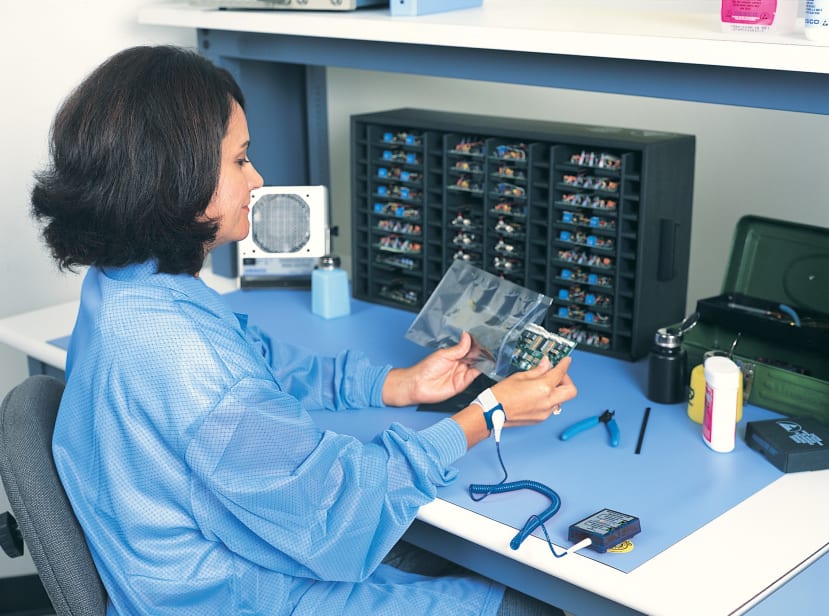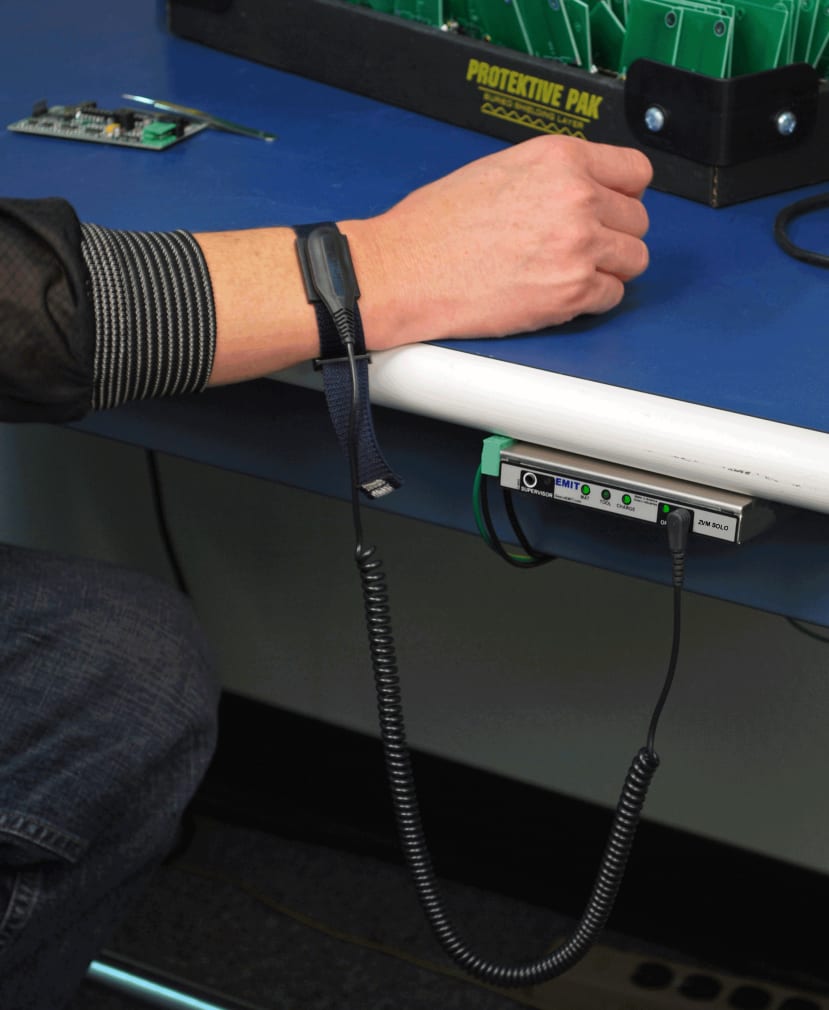Single-Wire vs. Dual-Wire Monitors
Follow articleHow do you feel about this article? Help us to provide better content for you.
Thank you! Your feedback has been received.
There was a problem submitting your feedback, please try again later.
What do you think of this article?
A wrist strap is arguably the best way to provide a safe ground connection to the operator in order to dissipate accumulated static charges with the purpose to prevent dangerous ESD exposure to sensitive ESD components.
Wrist straps must be tested to ensure that they are installed and working properly. On-demand or "touch" testers have become the most common testing method. On-demand testers complete a circuit when the wrist strap wearer touches a contact plate. One drawback with on-demand type testers is that they require a dedicated action by the wearer of the wrist strap to make the test. Also, knowing that the wrist strap has failed after the fact may possibly have exposed a highly sensitive or valuable assembly to risk. Continuous monitors eliminate the possibility of a component being exposed to ESD during the period that the wrist strap was not working properly.
Types of Wrist Straps
A wrist strap, in general, is a conductive wristband which provides an electrical connection to the skin of an operator and, in turn, by itself is connected to a known ground point at a workbench or a tool. While a wrist strap does not prevent generation of charges, its purpose is to dissipate these charges to ground as quickly as possible. A single-wire wrist strap is comprised of one conductive surface contacting the wrist of an operator and providing one electrical connection to ground. A dual-wire wrist strap has two electrically-separate parts and two separate electrical connections to ground combined in one cord.
A Wrist Strap
Both types of wrist straps – when in good condition and properly worn – provide equally good connection of operator to ground. A single-wire wrist strap is undoubtedly less expensive than its dual counterpart. However, for applications where sensitive components are being handled, the share of dual-wire wrist straps is growing rapidly. The reason for this is its ability to guarantee that the wrist strap indeed provides proper dissipation of charges on the operator. The way to ensure that the wrist strap is worn properly at all times is to utilise a continuous wrist strap monitor. These units monitor proper connection of the operator to ground and alarm should this connection fail. If you want to learn more about the benefits of continuous monitoring, we recommend you read this post.
Wrist Strap Monitors
Monitoring of single-wire and dual-wire wrist straps is fundamentally different:
- Single-wire wrist strap monitors do not have a return signal path; the only physical parameter they can rely on is parasitic capacitance of operator’s body to ground.
- Dual-wire wrist strap monitors measure the resistance of the operator’s wrist between the two halves of the wrist strap.
Single-Wire Wrist Strap Monitoring
1. AC Capacitance Monitors
The first constant monitors developed made use of the fact that a person can be thought of as one plate of a capacitor with the other plate being ground. The ground and the person are both conductors and they are separated (sometimes) by an insulator (shoes, mats, carpet, etc.) thus forming a capacitor. The combined resistance of the wrist strap and person forms a resistor so that the total circuit is a simple RC circuit. A tiny AC current applied to this circuit will cause a displacement current in the capacitance to flow to ground providing a simple way to make sure the person (capacitor) resistor (wrist strap) and coil cord are all hooked up. Any break in this circuit results in a higher impedance that can be used to trigger an alarm. AC capacitance monitors have a few drawbacks:
- They do not provide a reliable way to know if the total resistance of the circuit is too low, i.e., if the current limiting safety resistor is shorted.
- Simple AC capacitance monitors can be tricked into thinking the person is wearing the wrist strap when they are not. For example, laying a wrist strap and cord on a grounded mat will increase the shunt capacitance, which allows the monitor to show a good circuit even with the person out of the circuit. Forming the cord into a tight bundle or stretching it can also provide false readings.
- Since the capacitance and therefore the impedance of the circuit will also vary with such things as the person’s size, clothing, shoe soles, conductance of the floor, chair, table mat, the person's positions (standing or sitting), etc., these monitors often have to be "tuned" to a specific installation and operator.
This technology is still around today and is purchased by some because of its low cost and a lack of knowledge by the End-User. A big plus of this technology is the ability to use any standard single-wire wrist strap.
2. Wave Distortion Monitors
Many of the shortcomings of the capacitance and other earlier monitors have been overcome with the development of AC monitors that use the concept of the wrist strap wearer as a capacitor but in a different way. The concept of the wrist strap and wearer as an RC circuit is not wrong but it is an oversimplification. The total circuit actually contains resistance, capacitance and inductance (RCL). Each component value will vary with the environment, size of the wearer, and the other factors that affect the accuracy of the AC capacitance monitor. What the waveform distortion monitor looks at is not the impedance level, but at the waveform generated by the circuit. Current will lead voltage at various points due to the combinations of resistance and capacitive reactance. (There is a negligible amount of inductive reactance from the coil cord.) By monitoring these distortions" or phase shifts the WDM will determine if the circuit is complete i.e.; the wearer is in the circuit and the total equivalent DC resistance is within specifications given a range of installations. Essentially, the unit will monitor the operator by sending a "signature" signal down the coil cord to the operator's wrist. The operator acts as a load and will reflect that signal back to the monitor with a different signature. The monitor will then compare the reflected signature to its factory pre-set signatures. If the signal is within the "good" range, the operator passes and the monitor will continue its work. If the signature is "not" good, the monitor will go into an alarm-state to warn the operator to stop working and fix the problem.
Example of a single-wire wave distortion monitor
Wave distortion monitors solve many of the problems of the other types:
- It allows the use of any brand of single-wire wrist strap
- It cannot be tricked like the AC capacitance units
- It provides a warning if the lower (safety) resistance limits are compromised
- The tiny amount of current required to generate the waveform has never caused reported skin irritation.
As an added bonus, wave distortion monitors will also detect an open circuit or bad ground all the way back to the building ground point. This is a fundamental advantage of this kind of monitor. Other monitors may ensure that the operator is connected to the monitor. No other monitor automatically ensures that the user is actually grounded.
Dual-Wire Wrist Strap Monitoring
Dual-wire resistance monitors were developed to overcome some of the problems with the AC capacitance types. By providing a second path to ground (without relying on the capacitor above) we can apply a tiny DC current. It is then simple to measure the DC resistance of the circuit and alarm if that resistance goes too high (open circuit) or too low (the safety resistor is shorted). Thus, a two-wire monitor provides the same reliability as a touch tester and a simple, easy to understand measurement. The shortcomings with the AC capacitance monitor are eliminated. Two-wire monitors require two wires to work. This means that the wearer must wear a dual-wire two-conductor wrist strap/coil cord which are more expensive than standard single-wire wrist straps.
Example of a dual-wire monitor
There have been some reports that a constant DC voltage applied to the wristband causes skin irritations. This has been addressed in some models by pulsing the test current and in others by lowering the test voltage.
Conclusion
Dual polarity technology provides true continuous monitoring of wrist strap functionality and operator safety according to accepted industry standards. Dual-wire systems are used to create redundancy. In critical applications, you build-in redundancy to have a backup if your primary option fails. With dual-wire wrist straps, the redundancy is there as a protection rather than an alternative. If you are monitoring your dual-wire wrist strap and one wire fails, then the unit will alarm. You will still be grounded by the other wire, so there will be a significantly reduced risk of damaging ESD sensitive components if you happen to be handling them when the wrist strap fails. The wrist strap would still need to be replaced immediately. So, while both single-wire and dual-wire wrist strap monitors help to dissipate accumulated charges on an operator, only dual-wire wrist strap solutions provide assurance of a proper dissipative path from operator to ground.




